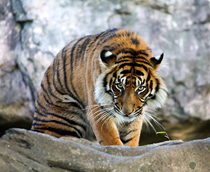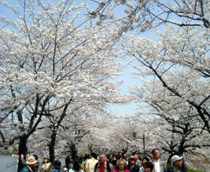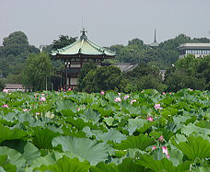
Travel Guide
Introduction
With cherry blossoms that bloom in spring and lotuses that flower in summer, Ueno Park, the oldest and largest park in the city, is regarded as being one of Tokyo’s most beautiful. Inside there are temples, shrines, and pagodas, also a pond, a zoo and some of Japan’s finest museums. Museums includes the Tokyo National Museum, the National Museum for Western Art, the Tokyo Metropolitan Art Museum and the National Science Museum, and Ueno Park is home to Ueno Zoo. In the open spaces there are often street performers showing off their juggling, diabolo, dancing and singing skills.
In late April to early May, the tree-lined promenade that runs southwards through the park is a very popular place for “Hanami” parties (cherry blossom watching parties). With more than 1,000 cherry trees, it gets pretty busy but it’s worth battling the crowds to experience this staple activity in the Japanese cultural calendar.
At the southwestern end of the park lies Shinobazu Pond, famous for its lotus flowers, and one of many reminders of Kaneiji Temple's former grandeur. The pond represents Lake Biwako (in a reference to Kaneiji's model, the Enryakuji Temple of Kyoto, which overlooks Lake Biwako). On an island in the middle of the pond stands Bentendo, a temple hall dedicated to the goddess of Benten.
Other well-known landmarks in Ueno Park are Ueno Toshogu Shrine, erected in 1651 and dedicated to Tokugawa Ieyasu, founder of the Tokugawa shogunate; and Kiyomizu Kannondo Temple, completed in 1631 as a much smaller copy of the famous Kiyomizu Kannondo Temple in Kyoto.
If you find yourself having exhausted the offerings of the park, exit to the south along the train tracks to discover Ameyoko Avenue with its jumble of market stalls. Here you can purchase anything from fish to jewelry in an atmosphere which evokes street markets throughout Asia. Or exit to the north-west to discover picturesque Yanaka and Nezu with its hidden art galleries (including SCAI The Bathhouse and Space Oguraya), interesting old houses, winding streets and friendly cafes.
But, especially in fine weather, there’s more than enough in the park to keep you occupied for a day. Pop into one of the museums for a few hours, saunter around the lake, pay your respects at the various shrines and temples, have a coffee while looking at the lotuses, and indulge in some good quality people-watching. There’s a bit of everything in Ueno Park, so there’s definitely something for you.
History
The park was established in 1873 on lands formerly belonging to the temple of Kaneiji Temple which was one of the city's largest and wealthiest temples and a family temple of the ruling Tokugawa clan during the Edo Period. Kaneiji Temple stood in the northeast of the capital to protect the city from evil, much like Enryakuji Temple in Kyoto.
Most of the temple buildings were destroyed in the Battle of Ueno in 1868 during the Boshin War, when the forces of the Tokugawa shogunate were defeated by those aiming at the restoration of imperial rule. In December of that year Ueno Hill became the property of the city of Tokyo, other than for the surviving temple buildings which include the five-storey pagoda of 1639, the Kiyomizu Kannondo (or Shimizudo) of 1631, and approximately coeval main gate (all ICPs).
The temple grounds were converted into one of Japan's first Western style parks and opened to the public in 1873. A statue of Saigo Takamori, one of the generals in the Battle of Ueno, stands near the park's southern entrance.
In 1924, in honour of the marriage of Hirohito, Ueno Park was presented to the city by Emperor Taisho, receiving the official name that lasts to this day of Ueno Onshi Koen, lit. "Ueno Imperial Gift Park".
 |
 |
 |
| Ueno Zoo | Cherry blossom | Shinobazu Pond |
Travel Advice
Autumn Leaves
Ueno Park is a spot to see autumn leaves. Please see Autum Leaves in Ueno Park.
Events
| Events in 2019 | ||
| Ueno Summer Festival | It features a different event everyday, like a toro nagashi paper-lantern floating ceremony, an ice-sculpture display, dance performances, stands to sell local specialties, antique market, and among them, Ueno Natsu Matsuri Parade is the highlight. | Jul 13(Sat) to Aug 12(Mon) |
| Events in 2020 | ||
| Ueno Cherry Blossom Festival | During the festival, 1,000 lanterns illuminate the park. Also, a lion dance, antique market and many other events invite people to celebrate the arrival of spring. | March 21(Sat)~ April 7(Tue) |
Visit
| Address | Ueno Park, Taito-ku, Tokyo | |
| Phone | 03-3828-5644 (Ueno Onshi Koen Management Office) | |
| Admission | Free | |
| Hours | 05:00~23:00 | |
| Closed | Open 7 Days a Week | |
| Duration | 45 minutes | |
| Getting There | By Train 2 minutes walk from Ueno Station on JR Line, subway Ginza Line or subway Hibiya Line. 5 minutes walk from Ueno-okachimachi Station on subway Oedo Line. 1 minute walk from Keisei-ueno Station on Keisei Line. By Car Take Shuto Expressway to the Ueno exit. It is approximately 5 minutes from exit. |
|
| Parking | Paid parking available | |

